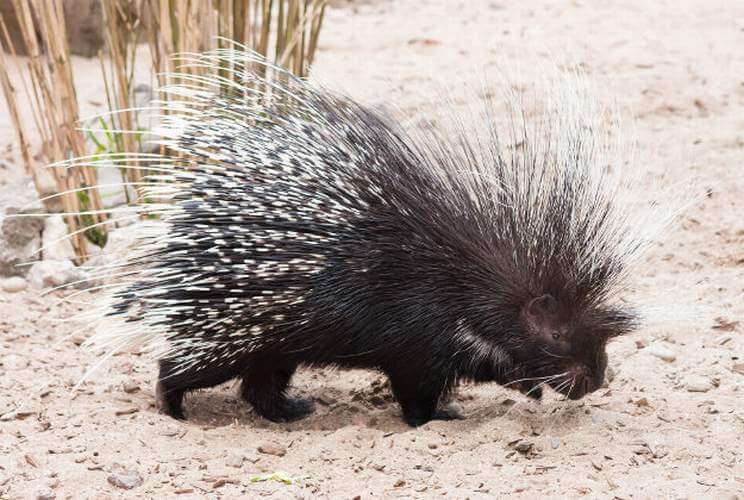Porcupine quills
Porcupine quills
Size: 6cm - > 25cm (L)
We have a large selection of African porcupine quills ranging in size and thickness from 6 cm to over 20 cm. The African porcupine is a large rodent found in Africa and the meat of the porcupine is considered a delicacy by locals that live off the land. Farmers consider porcupines to be pests as they destroy crops and often farmers shoot these animals to get them off their land. 
Porcupines have large black and white spines on their back which protects them from predators and these quills fall out easily and are found naturally in the wild. Porcupine quills are modified hair that has a thick coat and of keratin that is the same as the human nail. If you burn a porcupine quill you get the same smell as if you are burning a human nail. Quills that do fall out will regrow and replace any quills that have fallen out.
All our quills have been obtain through legal measures have been obtain from dead porcupines or quills that have fallen out naturally. We do not kill the porcupine just for the quills.
All sizes listed are approximate. The porcupine quills you purchase and receive may differ just slightly in size, look, and/or pattern from the African porcupine quills shown in the picture because of the nature porcupine quills each one is unique.
If you are looking for other African game skulls return to our main African animal skulls page.
Other styles skulls available on our main skull horns page
African Thick Porcupine Quills 6 - 8cm

$12-50
Region: South Africa
Material: Porcupine quill
Size: 6-8cm (L) - 30 loose thick quills
African Thick Porcupine Quills 8 -10cm

$18-50
Region: South Africa
Material: Porcupine quill
Size: 8-10cm (L) - 30 loose thick quills
African Thick Porcupine Quills 10 - 12cm

$20-50
Region: South Africa
Material: Porcupine quill
Size: 10-12cm (L) - 30 loose thick quills
African Thick Porcupine Quills 12 - 15cm

$22-50
Region: South Africa
Material: Porcupine quill
Size: 12-15 cm (L) - 30 loose thick quills
African Thick Porcupine Quills 15 - 20cm

$26-00
Region: South Africa
Material: Porcupine quill
Size: 15-20cm (L) - 30 loose thick quills
African Thick Porcupine Quills - 20cm & Bigger

$30-00
Region: South Africa
Material: Porcupine quill
Size: bigger than 20cm (L) - 30 loose quills
Add to Cart
African Thinner Porcupine Quills - 20cm & Bigger

$28-00
Region: South Africa
Material: Porcupine quill
Size: 25cm bigger (L) - 40 loose thinner quills



Facts about this animal
Porcupines are rodents, that is related to mice, rats and beavers. They live in America, Africa, Europe and Asia. Out of all porcupine species, only one (Philippine Porcupine) is listed as vulnerable. That means that it can become endangered in the near future. All porcupine species are similar at the first glance. They can live in deserts, grasslands or forests.
The porcupine is the prickliest of rodents, though its Latin name means "quill pig." There are about two dozen porcupine species, and all boast a coat of needle-like quills to give predators a sharp reminder that this animal is no easy meal. Some quills, like those of Africa's crested porcupine, are nearly a foot (30 centimeters) long.
Porcupines have soft hair, but on their back, sides, and tail it is usually mixed with sharp quills. These quills typically lie flat until a porcupine is threatened, then leap to attention as a persuasive deterrent. Porcupines cannot shoot them at predators as once thought, but the quills do detach easily when touched. Many animals come away from a porcupine encounter with quills protruding from their own snouts or bodies. Quills have sharp tips and overlapping scales or barbs that make them difficult to remove once they are stuck in another animal's skin. Porcupines grow new quills to replace the ones they lose.
The African Crested Porcupine will avoid dense rainforest's but can be found in virtually all other types of habitats. This species is proving to be very adaptable to the varied habitats of it's home range.
The long white hairs that protrude from the back of the African crested porcupine are often referred to as trigger, or guard hairs. These long sensitive hairs can often exceed two feet in length. The guard hairs differ from the quills which are rigid and sharp. The guard hairs are much denser than a human hair but are quite flexible and do not have a sharp point. Their primary purpose is to alert the porcupine as to the direction of the threat. Since the hairs are positioned around the rear of the animal, they act as the porcupines "eyes" as it can literally feel the predator and tell the exact direction to charge back wards. For example, once the porcupine is aware that a young lion has decided to make a meal out of the rodent, the porcupine will turn backwards and literally fluff up all of it's quills. As soon as the lion touches the long guard hairs on the right or the left side of the porcupine, the giant rodent will charge backwards in the direction of the disturbed guard hairs.
Factsheet
Scientific classification
- Scientific Name: Hystrix africaeaustralis
- Size: Length: 63cm-93cm
- Weight: 10kg-30kg
- Lifespan: 12 -15 years
- Habitat: Savanna and open grasslands varied habits
- Diet: Plant material which includes roots, bark, and other parts of many species of plants. Herbivores
- Gestation: 110 days
- Predators: Lions, leopards, cheetahs, hyenas, hunting dogs, farmers/humans
Conservation status: Least concern / abundant










